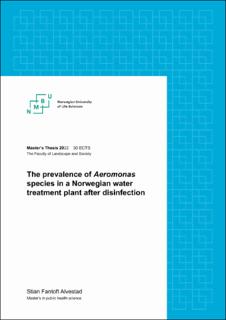| dc.description.abstract | Background: Microorganisms such as bacteria, viruses and parasites in drinking water may poses a risk to human health. Proteobacteria includes the most common pathogens isolated from drinking water. Belonging to this phylum, we find Aeromonas spp., which are bacteria that naturally reside in various aquatic environments. The most common clinical presentations of Aeromonas infections are diarrhea, wound infections, and bacteremia. Only a few studies have investigated the effect of various hygienic barriers and disinfection treatments on the prevalence of this pathogen in drinking water, and research is scarce in Norwegian settings. Therefore, this study investigates the effect of different treatments on the prevalence of Aeromonas spp. in a Norwegian drinking water treatment plant. Materials and methods: ten sampling points were tested weekly from September to November 2021 at various sites throughout the treatment plant. All samples were examined through three rounds of dilution, filtrated, and cultivated at 37°C for 20-24 hours on a selective Aeromonas medium with ampicillin. The quantified load was expressed in CFU/l with median and range. The Aeromonas prevalence was contextualized by descriptive trends of other drinking water quality parameters provided by the treatment plant. Inferential statistics were based on descriptive findings. Results: this study observed a great decline in median Aeromonas prevalence throughout the treatment process, with a 2.26 log10 reduction from raw water to clean drinking water leaving the treatment plant. Although a slight regrowth in the distribution network was observed, the median load is well below the infective dose reported for the most frequently isolated Aeromonas species, A. hydrophila. All sampling points appeared to have a declining Aeromonas load over the course of the study. Throughout the treatment course, the highest median Aeromonas growth was observed after the marble filter, with a 1.37 log10 increase from the sampling point before. The load remained elevated after the biological filter, and the median Aeromonas load observed after both filters were significantly higher compared to all sampling points except the raw water. Although a log10 reduction of 1.37 was observed from the samples before and after the ozone chamber, the greatest decline in median Aeromonas load was observed after the UV radiation chamber, with a 2.08 log10 reduction from the sampling point before. Conclusion: this study suggests that; (i) the environmental conditions such as temperatures and pH might favor Aeromonas growth, (ii) UV radiation seems effective in reducing the prevalence of this microorganism, and (iii) the observed Aeromonas load in the drinking water distribution may not pose a risk for human consumption. Nevertheless, more studies in a Norwegian setting are needed, both at different locations and in various seasons throughout the year. | en_US |

